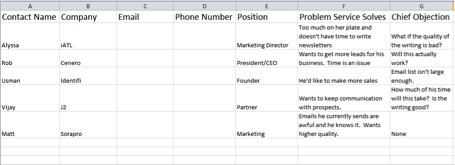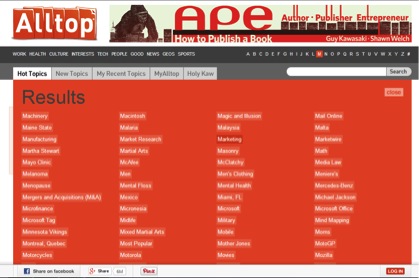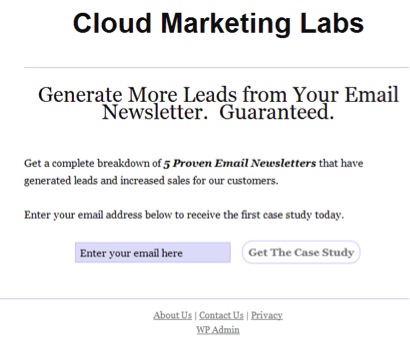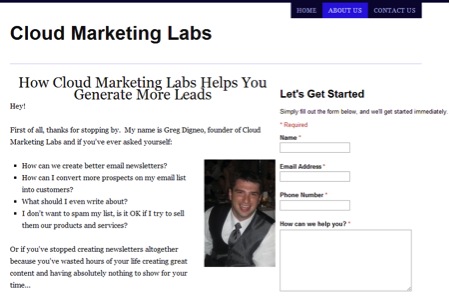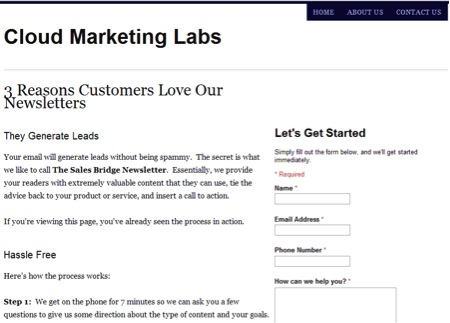Creating your first online marketing plan is so overwhelming, isn’t it?
Just taking a quick inventory of all the marketing strategies, tactics, tips, and tricks can make your mind swim in confusion.
There’s Facebook, Pinterest, Twitter, blogging, email, advertising, Tumblr, and the list goes on and on and on.
And everywhere you look, there’s some guru out there telling you how you can make a million dollars overnight with some “secret” or silver bullet.
If you’re looking for an over-hyped magic formula, then close this post because the rest of it is going to be a complete waste of your time.
But if you’re looking for a strategy that will grow your business over time, then stick around because I’m going to share my marketing plan with you. I’m going to show you in full detail exactly what I did to generate leads and sales.
Steal it and put it to use for your business. I give you permission. 🙂
3 Key Ingredients to Creating a Successful Online Marketing Plan
After marketing the products and services of other companies as a consultant, I finally set out to build a start-up of my own, including creating a marketing plan.
I never set out to publish it, but after showing some friends how I was able to get my first few online sales, I thought it might be useful to share to everyone.
Over time, I’ve come to learn that there are three key ingredients to every successful online marketing plan.
Get Traffic
The first ingredient to a successful online marketing plan is to get people to your blog or website or online store or Facebook page, or wherever. If you can’t get people to come to the location where you plan on making sales, your online marketing plan is cooked.
Video marketing is one way to get good traffic because consumers love to watch videos from different platforms, like YouTube and TikTok. As a tip, you can use video ad templates when creating short videos.
Get People to Know You
Some people call this ingredient engaging, others call this ingredient building authority. Personally, I just want to get as many people as I possibly can to know me and like me. It’s much easier to make sales to people who know and like me than it is to strangers. Be humble, approachable, and open. These must-have attitudes for entrepreneurs will increase your credibility and reputation.
Make the Sale
The third key ingredient to a successful marketing plan is to make the sale. If you’re able to get traffic and you’re able to get people to know you and like you, then making the sale becomes much easier. Closing more sales involve creating your buyer persona (ideal buyers) and nurturing potential sales into every stage of the sales funnel (sale process).
How to Create Your First Online Marketing Plan
Now I’m going to take you through all seven steps of the marketing plan.
Step 1: Who are you selling to?
It sounds obvious, but before you can begin marketing, you first need to identify who you’re selling to. I find this to be the biggest mistake business owners and marketers make.
The temptation is to sell to “everyone”, but the more specific you get, the easier it is to market your business.
To identify my ideal customer, I created marketing personas that were as specific as possible.
For instance:
- A business owner with a traditional sales team and relationship based sales process who wants to alert his customers of other products and service offerings.
- A busy marketing director who doesn’t have the time to create content, optimize a newsletter for various devices, or track conversions. She just wants to get her emails out and be able to show her boss results.
- These are businesses with at least $500,000 and no more than $10MM. This means they have between 5 and 50 employees. These are also “B2B” companies that could benefit from a consistent outreach program to their prospects and customers.
(My list of credentials is much more detailed, but I didn’t want to completely bore you. I hope you get the idea.)
Step 2: Make One on One Sales
Making one on one sales will accomplish two things. First, it’ll help you find your first few customers. But more importantly, it’ll allow you to hone your messaging. It’s a personalized way to approach your target customers in order to close more sales.
Once you’ve created your personas, create a list of 5-10 people you have direct access to on a spreadsheet similar to this:
Here’s the email that I sent out to this first round of prospects:
Hey Rob,
I’m looking to start a service that helps small and mid-sized businesses like yours generate leads without breaking the proverbial bank.
If you’re interested in learning more, let’s set something up for Friday at 2.
Regards,
Greg
Because I had a relationship and direct access with each person, my response rate was 100%. Once I set up the meeting, I wanted to do two things.
First, I wanted to make the sale.
Second, I wanted to listen to the objections they had. If I can’t identify and overcome the objections of people who I have a relationship with, then it’ll be impossible for me to do this online.
Step 3: Overcoming Objections
Objections are part of business dealings. So, it’s crucial to know how you can overcome the objections that you encounter with potential clients and interfere with your online marketing plan.
It turns out there were three objections:
1. “Will this actually work?”
2. “Will the writing be good? I don’t want to damage the relationship I have with my prospects with crappy writing.”
3. “Will this require a lot of my time? I’m busy enough as it is.”
To overcome these objections, I made a guarantee. “If the writing wasn’t up to their standards, I’d rewrite it until it was.”
Also, I had a predetermined set of questions that literally took 7 minutes to answer. So the only time restraint on them was 7 minutes.
And to overcome the “will it work” objection, I offered a free trial to a friend of mine so I would have a case study and testimonial to show off to my prospects.
Once I was able to show off a case study and demonstrate the quality of writing, it became a much easier sale.
Step 4: How to Get Referrals
Referrals are the quickest and easiest way to generate new leads, yet so few businesses ask for them. Don’t hesitate to obtain referrals because they can help you gain more clients in the future as you’ll be able to obtain some sort of social proof. Customer referrals are powerful like word-of-mouth or a viral video.
After I had finished my work with these original customers, I had three questions to ask them.
1. Was this a no-brainer for you? (They always answered “yes”)
2. Would this be a no-brainer for other businesses? (Again, they answered “yes”)
3. Would you introduce me to 3 CEO’s who have businesses about the same size as yours and could benefit from generating new leads? (Mostly answered “yes”)
Step 5: How Face-to-Face Sales will Help You Build Your Online Marketing Funnel
Now it’s time to take what I learned from my face-to-face sales and build out your online marketing funnel.
Based on what I learned, my marketing and website need to contain a few things:
- Case studies. People need to see the quality of the newsletter they can expect. They also need to see why and how they’re going to generate leads. A lot of my customers have been burned in the past and are skeptical of “marketing” services.
- A Guarantee. I’m going to keep the quality guarantee. So, this will help make it a no-brainer.
- Emphasize Leads. The primary reason these initial companies were excited about my service was the promise of new leads.
Step 6: How to Get Traffic for Free
My absolute favorite way to get traffic is by writing guest posts. Guest posting refers to writing web content for another website. As a guest blogger, you’ll write for similar blogs about topics of your expertise and within your industry to attract traffic back to your website. Using external links (links from other websites) is one way to boost your domain authority to high-authority domains.
First of all, they’re free. For entrepreneurs on a tight budget, you surely can’t beat this.
And second, the traffic that comes from a guest post is usually warmer than traffic that comes from an ad. In the past, I’ve found that a person coming from a guest post is 50% more likely to convert into a customer than a Facebook ad.
I don’t know if that will be the case here, but it’s a start.
Let’s Do Some Math
These are assumptions based on past experiences with other products and services that I’ve marketed in this price range and to this group of people.
- On average, each guest post will generate 80 emails and 10 new leads.
- I believe I’ll be able to close 3 deals out of those 10 leads.
- One guest post = 3 customers.
My goal is to get 50 more customers, so that means I’ll have to write about 17 articles just like this one.
In my experience, when you produce a large number of guest posts in a short amount of time, their effectiveness rises exponentially. Unfortunately, that is impossible to predict, so we’ll keep these numbers conservative for now.
Finding Guest Posting Opportunities
The first step to guest posting is finding blogs where your personas reside. The easiest way to do this is through a site called alltop.com.
Since one of my personas is marketing directors, I would guess they read a fair amount of marketing blogs. I’d go to alltop.com to find the extensive list of marketing blogs to see which of them accepts guest posts.
Another option to find guest post opportunities is to use Google.
One of my personas probably hangs out on small business blogs, so I would simply google:
“Small Business Blog” and “Write for us”
And what appears is a list of small business blogs who are looking for guest posts.
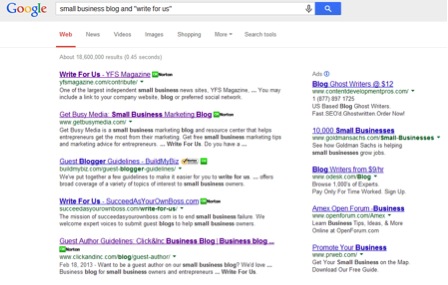
After I used both methods to find a list of places to guest post, I created a simple spreadsheet to keep track of which blogs accept guest posts, which blogs I’ve submitted posts to, and the status of each post.
Then I’d do the same for marketing blogs.
At the moment, I have a list of approximately 20 or so blogs to write for.
Reaching Out
Reaching out isn’t nearly as hard as some people want to make it out to be.
Usually, I just say something like:
Hey blogger
I noticed that several of your posts regarding lead generation get a lot of traffic.
For instance, the post “(insert title of post here)” got 300 tweets and about 200 other social media shares.
Would it be cool if I created a post called “(insert post title here)”? I can get it to you by the end of the week.
Regards,
Greg
By using this exact script, I’ve been able to write for popular blogs like this one, this one, and this one.
The hard part isn’t reaching out to bloggers, it’s creating great posts. In fact, this post, from beginning to end took nearly 9 hours to write. But overall, it contributes to a great online marketing plan.
Step 7: A Step-by-Step Guide to a Marketing Funnel that Converts
If you want to create a marketing funnel that converts, you have to apply critical thinking and problem-solving skills. Hence, think of ways to get into your customers’ minds by using the information they provide or details readily at hand. Here’s an example:
Once I get traffic back to my site, I’m going to need to convert it into sales. I’m making two assumptions here.
Assumption 1: I’m going to need to collect email addresses first.
Assumption 2: I’m not yet ready to make this an automated web-based sale. I think I’m going to need to get the person on the phone first. Eventually, I’ll move forward and test out an automated sale.
Based on my face-to-face sales, I decided the best way for me to collect email addresses is with case studies.
This will show prospective buyers the quality of emails they’ll receive and explain why they work. The home page of the website is designed to collect email addresses. Plus, it’s essentially a landing page, and that’s not an accident.
My prospects are not going to buy my email marketing service on a whim. My face-to-face sales told me they’ll need to be educated.
After a person confirms their email address, they’ll receive the first of five case studies.
Also, they’re taken to my “About” page. So, this is the page where I tell the story of the company and who I am. As I stated before, it’s easier to get people to buy from you once they know who you are.
At the bottom of each case study, there is a link to my services page. The goal of the services page is to get prospects to sign up for a consultation. This is where they could see if the service is right for them.
On the services page, I again try to overcome the objections a person might have based on my face-to-face sales.
Are you ready to implement a proven marketing plan?
If you stuck with me throughout this entire post, then you have the tools you need to sign up more clients, get more customers, and grow your business.
The only question is, are you willing to use these tools?
Like I said at the beginning of this post, this surely wasn’t going to be some magic pill or silver bullet. This is a marketing plan that you can implement over time and see results.
So here’s how you can get started.
First, I want you to take a deep breath. You just consumed a lot of information and I’m sure your head is swimming with ideas.
Second, print out this post, or bookmark it, or whatever you need to do and start at step #1 and create your buyer personas.
Finally, move through this plan at your own pace. There’s no rush and certainly no need to feel like you have to do all of this in one night.
Take your time.
Just promise me one thing. When you become rich and famous, all I ask is that you remember me.
Updated: March 17, 2021
Greg Digneo is on a mission to help B2B companies create email newsletters that generate revenue without being spammy.
Related Post: T Shirt Prices: Finding the Sweet Spot


